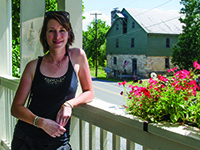On Edge for Spring Gobblers
By Doug Humphreys
Ecologically speaking, an “edge” is the boundary between two distinct environments. It might be where a hardwood forest meets a hayfield. It could be timberline or where a dense pine forest meets the shore of a lake. As hunters we know from experience that an edge usually means game. But why?
To fully understand why game gravitate to edge environments, one must first understand the ecological phenomenon known as “edge effect.” The extreme case of a mature hardwood forest that borders a cultivated field is a good case study that dramatically illustrates edge effect.
The canopy of a mature hardwood forest minimizes the amount of light that reaches the forest floor and, as such, limits the quantity and type of vegetation that can survive in the understory. When a mature hardwood forest ends abruptly at the edge of a cultivated field, the characteristics of the forest edge are different than that of its interior. Wind and sun are able to penetrate the forest edge and create a drier environment with more available light—conditions favored by opportunistic species. This allows shade intolerant species to exist beneath the canopy, as they are able to take advantage of the light penetrating from the edge opening.
The edge ecosystem provides a perfect combination of food and cover for both game and non-game species. The open side of the edge provides grasses, grain, or legumes; which will vary based on whether or not the field is cultivated. The edge itself will provide abundant browse on the understory species and high levels of hard and soft mast, as species at the edge take advantage of available sunlight. When an animal senses danger, it can escape to the protection of the forested side of the edge.
Turkeys utilize edge areas for multiple reasons. They use the open side of an edge for scratching and take advantage of the inherent protection provided by the edge understory. In spring, toms strut along an edge and use the edge for breeding. Hens nest in the thick understory at the edge ensuring food for themselves and protection for their clutch, roosting in the tall trees overhead.
Hunting spring gobblers in an edge environment is an exercise in patience. A turkey hunter can begin the day by using the cover of morning darkness to enter a field and pinpoint the location of a gobbling bird still on the roost. When an active bird is located, the hunter can discretely position at the edge near the gobbler’s location. The gobbler will likely come off the roost into the field to strut at dawn.
Being positioned on the edge near the location of an early morning gobbling bird can present a shot as the bird struts along the edge looking for a challenger or a breeding hen. A hen decoy positioned 20 yards into the field can help draw a tom toward the hunter as well as divert attention away from any movement the hunter might make. Calling should be kept soft and to a minimum, the decoy should be the primary tool to bring an energetic morning bird into range.
During midmorning, when the hens go to nest, the gobblers will often head to an edge area to establish dominance and scratch. Patience is imperative during midmorning hours. The birds will typically gobble less and, unless they are fighting to establish a pecking order, content themselves to scratch in and out of the edge as they mosey with no particular purpose. A jake decoy will pique the interest of an older, dominant bird, and lure him into range. The occasional call to bring life to the decoy is fine, but don’t overdo it.
When hens come off the nest in late morning to stretch their legs and look for a mate, toms will often gobble with the regularity and vigor one would expect at dawn. A hen decoy in the field, supplemented with a jake decoy, will attract the attention of a mature tom. Call enough to get the attention of an active bird, but, again, keep calling to a minimum.
Choose a camouflage that matches the environment and season. In the early part of the season, before foliage is heavy, I use a tree bark pattern of some design. As the woods green up, I switch to good old-fashioned woodland camo.
To most people, edge effect is a relatively mundane ecological process. To turkey hunters it is a literal natural wonder. Next time you are in the woods looking for a long-beard, do what I do. Get on edge for spring gobblers.













